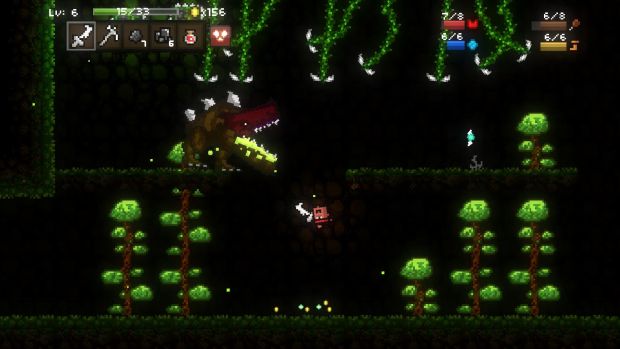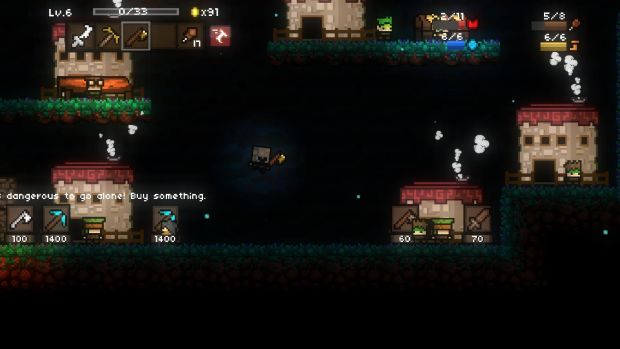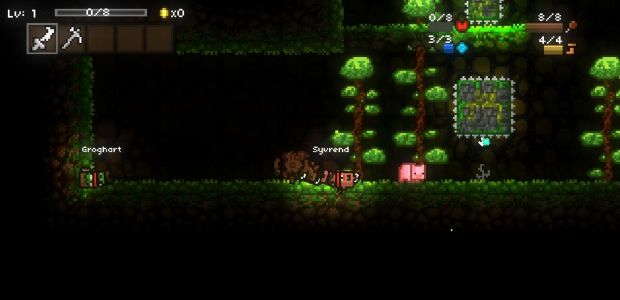Wot I Think: Magicite
Not magishite
You could be forgiven for thinking you'd seen Magicite before: it's a low-fi indie RPG-platformer that uses perma-death and procedural generation to create an endlessly replayable dungeon crawler, item grabber, monster slayer. It sexdecupled a $1,000 Kickstarter goal in November on the back of all that, plus promises of crafting and multiplayer. There's nifty character customisation too and, as a kicker, it's bastard hard. Here's Wot I Think.
It took me a good two hours to make it past the first level in my initial playthroughs of Magicite. It conclusively, repeatedly kicked my ass up and down its pixelated forest and I did not enjoy it. There was none of the humourous falling apart of an FTL run or the sense of increasing threat given off by The Binding of Isaac, just the cold sensation of slowly grinding my forehead against a game that was giving me nothing. It felt clunky and simple, difficult to the point of aggravation and with few things to think about beyond the basic combat system.
I've since discovered that this was, at least partly, down to me being utterly terrible.
Which certainly wasn't from lack of experience - if you've played a game since 1989 you'll understand Magicite in a moment. Jump, double jump, dash, don't let the enemies or fireballs touch you and hit them with whatever you have to hand. Kill monsters, get loot and xp to improve your gear and character along broad paths that analogise to rogue, warrior and mage. That it was so immediately familiar on the surface was part of my frustration. It was so obviously a game I should have understood, mastered and enjoyed, if it was of any notable worth, from the first moment. That was foolish and arrogant, an assumption that I could not be surprised by a simple platformer in the year 2014.
The very lethality of it is central to both the frustration and the appeal. Most enemies are tricky in their movement or deliver attacks which sap the lifebar at a frightening pace. Hopping blobs of goo which will always bloody move as you go in for the kill. Charging bulls that love to run just that little bit further than expected. And the bees, oh dear holy mother of honey christ the god damn bees. I'm likely misattributing their race, given the wasp-like structure of their body. In my defense, screw those little bastards and their unpredictable flight paths.
And that's just the first of the biomes. As I (eventually) progressed, each new environment - selected from three at the end of each level and accessed after a short interlude in a town - spewed forth a host of fairies, cannibals and at one point a dragon. Something's a little off in this progression though. The biome decides how difficult an area is, as opposed to how many you've already beaten. These aren't made any more common as you progress so it's normally best to return to the easier ones whenever possible and use your upgraded gear to curb stomp it.
The town I mentioned is where the majority of gear is acquired, by crafting the bits of material you've picked up on the way. It's a two-factor system of certain things being craftable in just your inventory, and thus available on the fly, while others require a forge or leatherworker. Mirroring most of the game's ideas, it's simple but effective, creating the occasional mini-dilemma of deciding what you need mid-run and what you can afford to bin. Again there's a balance issue though, where the most useful items are all crafted from the same set of materials - ore - and require little else. Equally, the randomly generated pair of stores in town could be exploited rather easily once I realised that items sold for more based on their number, not quality. Cutting down every tree in an entire region before exiting became a very good money-making tactic that let me buy into upgraded equipment earlier.
Upon death is when the influences of another popular cartoonish roguelike platformer come into play - Rogue Legacy. During play a bunch of invisible milestones will be hit: enemies killed, ores mined, plants harvested, that sort of thing. These are then tallied at the end of a run into a high score for posterity, but each one also has a chance of unlocking a new race, hat or variant. Variants are simple skin changes, a different set of ears, a longer hairstyle, cosmetic options with no effect. Races and hats are much more interesting, providing stat boosts and different starting items in the former, and various wacky changes to how the game operates in the latter. A race may start without an axe (vital for harvesting wood, Magicite's base resource from which a majority of items are created) but with access to mid-game equipment. My favourite hat, a berserker scarf, grants a 33% chance to increase the attack stat upon every level up, on top of whatever else was randomly increased.
Once more it's the balance of the system that I take issue with, but this time I think there's a design solution beyond tweaking numbers. By borrowing more heavily from Rogue Legacy and not allowing wholly free mix-and-match choice between the unlocked options, the design would prevent me from always picking the combo I find works best. It would also remove the incentive to continuously re-roll starting stats and abilities for that race's preferred progression path. I realise I'm complaining about having too much choice, but when dealing with so many different elements, keeping them balanced and encouraging players to try new things is nigh impossible. A one-in-a-hundred run might currently yield three or four new options, none of which I want to try because my tested formula serves me so well.
The combat can carry the game through any bumps this further randomisation might cause. It's fast and caricatured, jumps sending my character dozens of times their height into the air while weapons are comically oversized. The art really holds it together, picking out valuable pieces of terrain and threats from the background with ease. It's a shame there's no real sense of exploration beyond progressing further into the game. Each level is mostly a left to right side scroller, the full height of which can be easily viewed from the centre of the screen. When you do see a new area for the first time it feels like a real triumph though, with the obscene difficulty of the initial learning curve breeding increased reward.
The repetitive attempts for a good run exposed something of a weakness in the way I play games. I don't do short bursts, instead taking every game as a marathon and challenging it to tire me out before I finish it. That just doesn't work with Magicite. Sure, grinding out a few runs that end early is fine and quite plausible given there's an option on death to retry with the same character in a newly generated world. However, the set back from a thirty or forty minute, twelve level deep trek to nothing is absolutely crushing. Even if you unlock several new, usable options, the return to being threatened by those early bees isn't softened. It's not necessarily a weakness, it just requires that a player step away between games to regather their bearings. A much requested feature on the official forums is a save that is erased upon death, but allows the longer sessions to be split, and that feels in step with the rest of the game.
In multiplayer, Magicite takes on a whole other tone. It's as simple as more player characters trekking through the same environments, but with harder hitting and more damage spongey enemies. The increased player count means resources are more scarce (though XP is shared), but allows for specialisation. One person may spend all their wood and money on upgrading their axe, so trees will yield more items and the money from those can be spent on the group. Equally there will be a miner or combat specialist who rolled abilities and race based on heading in those directions. It's actually a far more interesting way to play, with the added bonus that a party is not wiped out until all its members are dead, and they may resurrect one-another with ease. It's even more ball-kickingly challenging than playing solo of course, with the increased deadliness of the foes and the natural lack of coordination between players. It's limited to direct connection hosting at the moment and would benefit heavily from local single-screen co-op or at the very least a matchmaking function.
Ultimately, my problem with Magicite is it never seems to hit the highs of the games it has stapled together. Spelunky is the natural comparison, another game that I failed to get on with early on. I never persisted with it, not having a review to write, but Magicite has shown me why so many fell in love. Unfortunately, Magicite also lacks the daily challanges, leaderboards and exploration of that game. It hasn't benefited from anywhere near the same amount of time in development, or the feedback that comes from multiple major releases. Solo developer Sean Young's still supporting the game and, even though the version number is at 1.0, it definitely feels like there's a way to go before it's finished. If you've three mates to jam it with or find this brand of perfection-seeking masochism to be particularly enjoyable, there's fun to be had - but you might have got it elsewhere already.
You can grab Magicite on Steam for £6.99.



